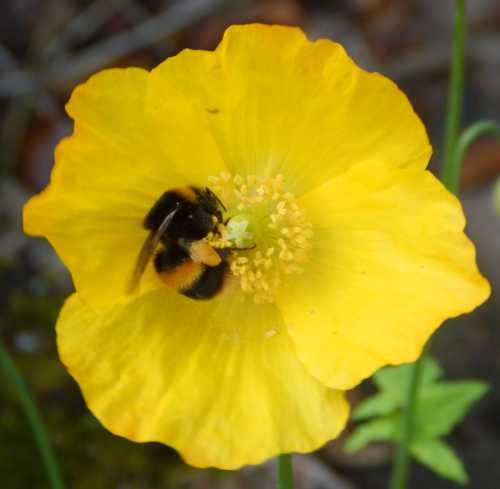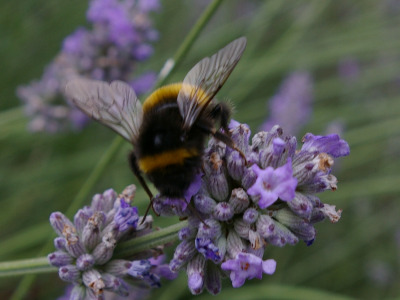The Bumble Bee Life Cycle
Updated: 27th April 2021
The bumble bee life cycle starts with an
impregnated queen after she emerges from her shelter from her winter snooze (actually called winter diapause1).
In order to prepare herself for the cool temperature, the young queen bumble bee will first do a little ’warm up’ – just as you or I may do our own little ‘warm up’ routine before going for a winter jog.
To do this, she vibrates her flight muscles very fast to generate heat, and when ready, she’ll take off to look for pollen and nectar.
The bumble bee life cycle starts with the queen
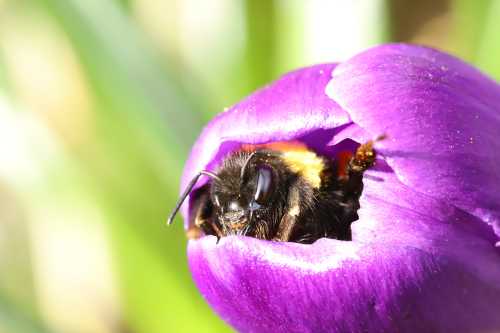 Bumble bee in a crocus flower
Bumble bee in a crocus flowerDepending on the species, some of these queen bumble bees will appear in the spring from March onwards. However, some species may appear as early as February. For the queen bumble bee, this is a very vulnerable time.
Pollen and nectar sources are scarce, and she’ll need to find both very quickly in order to sustain her during these crucial days.
Nectar gives her
energy whilst pollen helps her to replace vital body fats. Pollen also
provides protein to help her ovaries mature, and is needed later to feed
her brood.
(Read more about why bees need nectar and pollen).
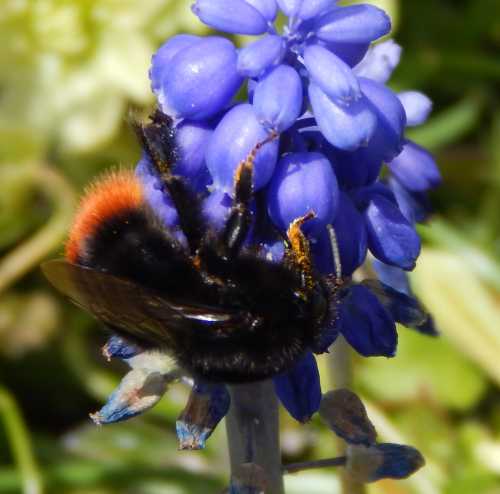 Queen red-tailed bumble bee Bombus lapidarius on Muscari
Queen red-tailed bumble bee Bombus lapidarius on MuscariDuring this time, winter and early spring flowering shrubs and plants, such as mahonia, pussy
willow, rosemary, winter heathers, blackthorn, berberis, crocuses, and Muscari (grape hyacinth) provide a vital life line for bumble bees.
Once the queen bumble bee has recovered, her next task is to find a suitable place to nest.
Some species, notably the carders, prefer to nest on the surface of the ground, perhaps on tussocky grass.
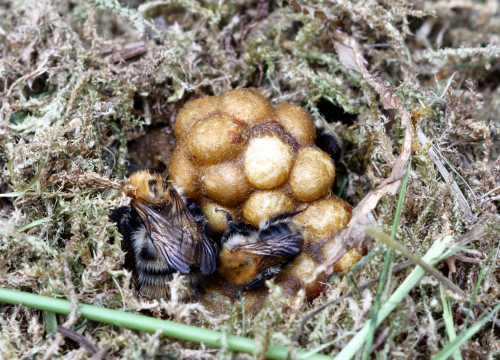 Nest of a common carder bumble bee, Bombus pascuorum showing wax cocoons.
Nest of a common carder bumble bee, Bombus pascuorum showing wax cocoons.Other bumble bee species are cavity nesters, perhaps making use of a hole in the ground (such as an abandoned rodent hole), or other the gaps between the roots of trees.
Nests may also appear in elevated locations, such as under the eaves of a house, a hollow in a tree trunk, or even a bird nest box can provide a suitable home, depending on the species.
Below is a lovely short video following a queen bumble bee as she establishes a colony, in a building:
Again, depending on the species, there are slight differences in the way broods are reared, however, a general description is as follows:
Once the nest site has been located, the queen bumble bee will build a little wax cup inside it, which she will fill with nectar to sustain her whilst she incubates her eggs.
She’ll also create a further wax cell, in which she will deposit a mound of pollen, and then lay her eggs on top of it.
She will then incubate the eggs by lying on top of them, and again, by vibrating her flight muscles to generate heat to a temperature of around 30 °C2.
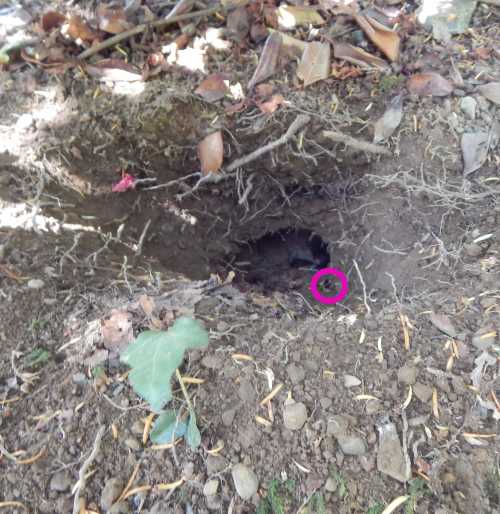 Site of a bumble bee nest - highlighted by the pink circle, a bumble bee entering the nest.
Site of a bumble bee nest - highlighted by the pink circle, a bumble bee entering the nest.The larvae
After about 4 days, the eggs hatch into larvae (these look a little
like maggots).
The larvae continue to feed and develop, and will go through a number of stages in development (shedding their skin 3 times) until after about 14 days, they produce silken cocoons and pupate. Within the pupae, the larvae shed their skin once more, and undergo metamorphosis.
After about 14 days, the little grub-like larvae are
transformed into a young bumble bees, which bite their way out of their
cocoons.
Worker bumble bees
The first bees to emerge from these cocoons are young female workers.
Within a day or two, these
workers will set about helping the queen, initially with nest duties,
but some will then go out to forage for pollen and nectar for rearing
the next brood (currently in development, and usually more workers).
A colony of bumble bees could
have between 50 – 500 workers, but will commonly consist of around 120
to 200. See: How many bumble bees in a colony?
Emergence of males and new young queens
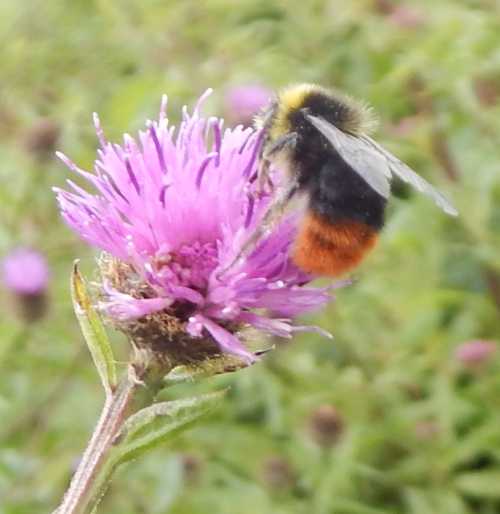 A Bombus lapidarius - red-tailed bumble bee male
A Bombus lapidarius - red-tailed bumble bee male
At some point, the queen will stop producing workers, and will switch
to rearing males and young queens.
Once the males have emerged, they
will soon leave the nest in search of mating opportunities. The young queens may remain in the nest for a while, laying down fat reserves in preparation for the winter hibernation (diapause).
All being well, a honey bee colony should survive the winter. However, in the case of bumble bees, the whole colony will die, apart from the new queens. The new queens leave the nest, mate, then hibernate, and re-emerge the following year to establish new colonies of their own.
And so the next generation of bumble bees begins ...
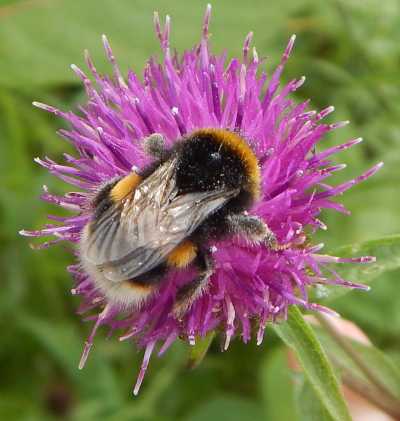 Bombus lucorum - white-tailed bumble bee queen on knapweed.
Bombus lucorum - white-tailed bumble bee queen on knapweed.
Providing Habitat For Bumble Bees
It is a good idea to provide plenty of foraging opportunities, with an abundance of flowers over a long season. Take a look at my lists of plants for bees.
You may wish to consider providing artificial nest sites for bumble bees. You can do this by purchasing one, however, success is far from guaranteed, and indeed, you may have more success with a previously used bird box, or an upturned plant pot under the garden shed.
My personal recommendation is don't try to force a bumble bee to nest in a 'bee house' you have purchased, instead, allow nature to take its natural course.
Ever wondered......
Do bumble bees make honey?
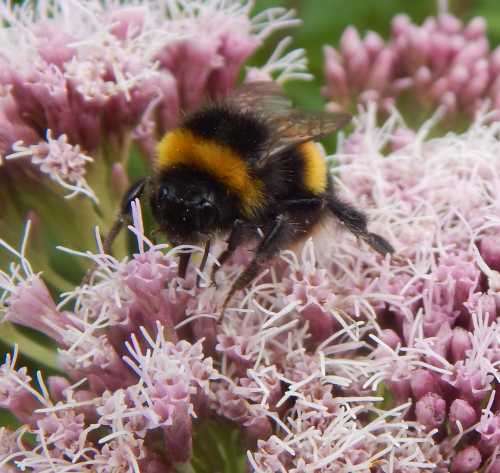
References
1. Erica Sarro, Penglin Sun, Kerry Mauck, Damaris Rodriguez-Arellano, Naoki Yamanaka, S Hollis Woodard, An organizing feature of bumble bee life history: worker emergence promotes queen reproduction and survival in young nests, Conservation Physiology, Volume 9, Issue 1, 2021, coab047, https://doi.org/10.1093/conphys/coab047
2. Goulson, D. 2010. Bumblebees, behavior and ecology. Oxford Univ. Press, Oxford, U.K, pg 4.
